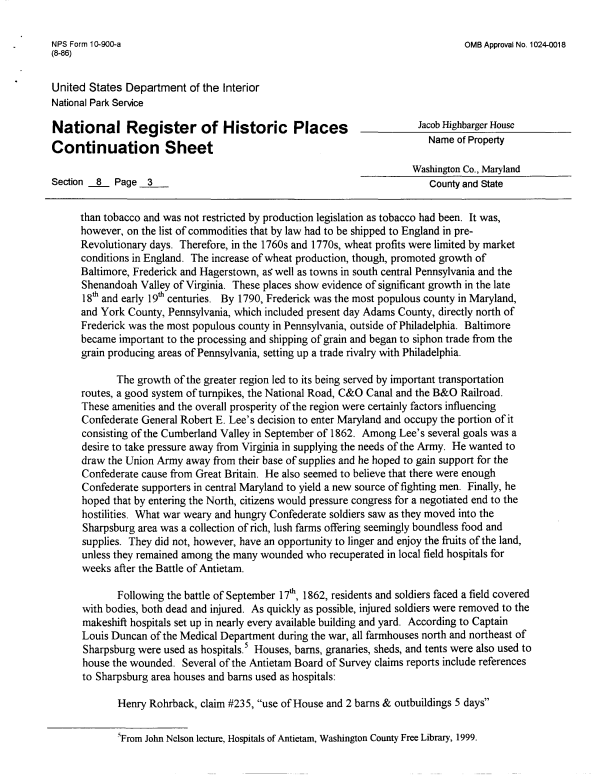 |
||||
|
DEPARTMENT OF HOUSING AND COMMUNITY DEVELOPMENT, MARYLAND HISTORICAL TRUST (Historic Sites Survey) var.d. MSA SE16-10 Image No: se16-10-0416 Enlarge and print image (76K) |
 |
||||
|
DEPARTMENT OF HOUSING AND COMMUNITY DEVELOPMENT, MARYLAND HISTORICAL TRUST (Historic Sites Survey) var.d. MSA SE16-10 Image No: se16-10-0416 Enlarge and print image (76K) |
| NFS Form 10-900-a OMB Approval No. 1024-0018 (8-86) United States Department of the Interior National Park Service National Register of Historic Places ____JacobHighbargerHouse___ f^ ,. ,. n m t Name of Property Continuation Sheet Washington Co., Maryland Section _8_ Page _3__ County and State than tobacco and was not restricted by production legislation as tobacco had been. It was, however, on the list of commodities that by law had to be shipped to England in pre-Revolutionary days. Therefore, in the 1760s and 1770s, wheat profits were limited by market conditions in England. The increase of wheat production, though, promoted growth of Baltimore, Frederick and Hagerstown, as" well as towns in south central Pennsylvania and the Shenandoah Valley of Virginia. These places show evidence of significant growth in the late 18th and early 19th centuries. By 1790, Frederick was the most populous county in Maryland, and York County, Pennsylvania, which included present day Adams County, directly north of Frederick was the most populous county in Pennsylvania, outside of Philadelphia. Baltimore became important to the processing and shipping of grain and began to siphon trade from the grain producing areas of Pennsylvania, setting up a trade rivalry with Philadelphia. The growth of the greater region led to its being served by important transportation routes, a good system of turnpikes, the National Road, C&O Canal and the B&O Railroad. These amenities and the overall prosperity of the region were certainly factors influencing Confederate General Robert E. Lee's decision to enter Maryland and occupy the portion of it consisting of the Cumberland Valley in September of 1862. Among Lee's several goals was a desire to take pressure away from Virginia in supplying the needs of the Army. He wanted to draw the Union Army away from their base of supplies and he hoped to gain support for the Confederate cause from Great Britain. He also seemed to believe that there were enough Confederate supporters in central Maryland to yield a new source of fighting men. Finally, he hoped that by entering the North, citizens would pressure congress for a negotiated end to the hostilities. What war weary and hungry Confederate soldiers saw as they moved into the Sharpsburg area was a collection of rich, lush farms offering seemingly boundless food and supplies. They did not, however, have an opportunity to linger and enjoy the fruits of the land, unless they remained among the many wounded who recuperated in local field hospitals for weeks after the Battle of Antietam. Following the battle of September 17th, 1862, residents and soldiers faced a field covered with bodies, both dead and injured. As quickly as possible, injured soldiers were removed to the makeshift hospitals set up in nearly every available building and yard. According to Captain Louis Duncan of the Medical Department during the war, all farmhouses north and northeast of Sharpsburg were used as hospitals.5 Houses, barns, granaries, sheds, and tents were also used to house the wounded. Several of the Antietam Board of Survey claims reports include references to Sharpsburg area houses and barns used as hospitals: Henry Rohrback, claim #235, "use of House and 2 barns & outbuildings 5 days" 5From John Nelson lecture, Hospitals of Antietam, Washington County Free Library, 1999. |